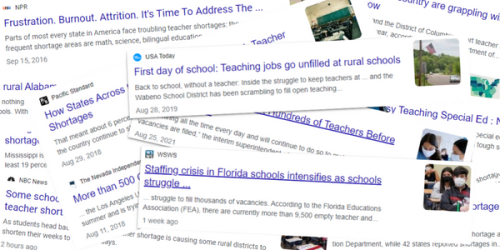A focus on teacher recruitment without appropriate attention to retention is like trying to collect water in a sieve. Lately, there has been much talk in the media about national teacher shortages (a narrative that persists despite little data or specificity). Yet there is no commensurate attention to keeping effective teachers in classrooms that need them most.
While it is imperative to address the dearth of timely, detailed teacher workforce data so that we can better identify the specific teacher shortages that schools and districts are facing, there are actions that states and districts can take now to keep the great teachers that they already have.
Here are eight steps states and districts can take now to keep an effective, diverse teacher workforce:
1. Collect and publish data on teacher attrition and retention disaggregated by school, student, and teacher demographics: We cannot fix a problem we cannot see. While 20 states claim to collect and publish some kind of teacher attrition data, none are actually reporting these numbers in a timely enough manner to be helpful. If states don’t have up-to-date information about their true teacher needs, they cannot generate data-informed policies and evaluate their impact.
2. Maintain high standards for entry and evaluate impact: Teaching is a rewarding and demanding job. Making it easier to enter the classroom belies the challenges that teachers will face once there. Teachers who hold emergency or alternative licenses are more likely to leave teaching, so short-term fixes are not long-term gains. Moreover, dropping standards like licensure tests is often proffered as a step to diversify the teacher workforce, but a recent RAND survey found that teachers of color did not believe this would be an effective strategy. Since 2020, at least 12 states have lowered requirements for licensure exams that assess if aspiring teachers have a firm grasp of the content they will be teaching, with additional states creating new emergency pathways to teacher licensure or removing other licensure requirements. States that do this must track data on where these new entrants go to teach, the demographics of the teachers and students, and assess their impact on student and teacher outcomes.
3. Set expectations for and monitor induction and mentoring: New teachers who are assigned mentors and who participate in an induction program are much less likely to leave their schools and teaching in general after their first year. This is especially critical for teachers entering through alternative routes, who may be less prepared than their fully certified counterparts. Moreover, new teachers supported by highly trained mentor teachers have helped their students achieve tremendous learning gains. In 2020, NCTQ found that only 27 states have specific requirements for mentoring and induction for alternative route teachers. Further, the mentoring and induction approaches among large districts similarly vary widely. Bringing in teachers who are not fully prepared and then leaving these new teachers to fend for themselves will only cause harm to students and will likely contribute to these teachers leaving, repeating the pernicious cycle.
4. Pay for what matters: This is not a new idea, yet it is still underused. All teachers deserve a reasonably high baseline salary, but states and districts can build upon that baseline with strategic pay designed to attract and retain teachers in hard-to-staff subjects and schools. In fact, some types of strategic pay (e.g., relocation assistance, loan forgiveness, pay for teaching in a harder-to-staff area) are associated with greater teacher diversity. Yet too few districts offer strategic pay targeted to their needs. Almost 90% of states and districts have compensation policies that allow for higher pay for teachers who attain a master’s degree, despite the fact that this does not correlate with better outcomes for students and, in many cases, doesn’t impact specific shortage areas. A recent NCTQ analysis of 148 large U.S. districts found almost half of the districts in our sample (70) do not offer or specify extra pay for special education teachers, but they do offer, on average, $6,600 extra pay for teachers with master’s degrees. And yet we persistently hear about districts struggling to find special education teachers—and research finds special education teachers are particularly at risk for leaving teaching.
5. Support students so teachers can focus on teaching: As teachers support students in the aftermath of the pandemic, a survey of 1,000 teacher respondents with findings reported in an Annenberg working paper suggests that what may be appealing to teachers is having more supports available for their students. Teachers found school counselors, a school nurse, and in-class special education specialists even more appealing than a 10% pay raise; these additional supports both benefit students and delegate some of the non-instructional responsibilities.
6. Provide access to evidence-based curricula and aligned, job-embedded professional learning: Curriculum matters to student outcomes and high-quality curriculum serves as the keystone in high-performing countries across the globe. States can use federal pandemic relief funds to invest in providing teachers with access to these high-quality curricula and to job-embedded professional learning to support skillful implementation. Although there is not yet research that links evidence-based curriculum to teacher retention, high-quality curriculum contributes to better student outcomes; and when teachers experience satisfaction and a sense of success with their students, they are more likely to stay.
7. Support principals to make a difference: Principals set the school culture that attracts (or repels) a diverse, high-performing teacher workforce and, when effective, can support them to thrive—as they are responsible for building the conditions that determine whether effective teachers stay or walk out the door. Teachers of color are more likely to want to stay in the classroom long-term when they have a supportive administration (e.g., the principal supports and encourages staff, recognizes good work, and has a clear vision for the school). States should set high standards for principal preparation and high standards for principal performance, and hold principal preparation programs and districts to account.
8. Implement a strong teacher evaluation system: Effective teachers are more likely to stay in schools where they are supported to develop and regularly receive feedback on their instruction. A meta-analysis of 120 studies on teacher attrition and retention found that being evaluated, even within an accountability system, did not increase teacher attrition. In fact, evaluating teachers improves retention for the most effective teachers. States have a central role to play in designing evaluation systems, supporting effective implementation and measuring impact.
Getting teachers into the classroom is only the first step. Strengthening our teacher workforce means helping teachers stay in the classroom, and supporting them to become increasingly effective—and happy with their career choice—once they’re there.
More like this

How are school districts using strategic pay to attract and retain teachers where they need them?

What teachers really want: It isn’t just higher salaries

Building a school climate that makes teachers want to stay

The revolutionary retention strategy of investing in beginning teachers



